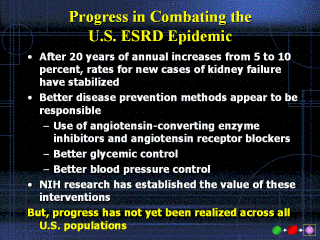Credit for these recent gains likely goes to clinical strategies
proven in the 1990s to significantly delay or
prevent kidney failure. These
include the use of angiotensin-converting enzyme inhibitors
(ACE-inhibitors) and angiotensin receptor blockers (ARBs), which
lower protein in the urine and are thought to directly prevent
injury to the kidneys’ blood vessels; as well as careful control of
diabetes and blood pressure.
NIH research has demonstrated the value of these approaches in
clinical trials. However, the
overall improvement in the ESRD landscape is not seen in all
Americans with the disease.
